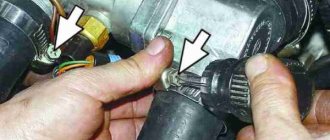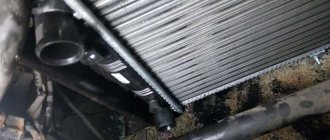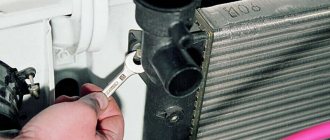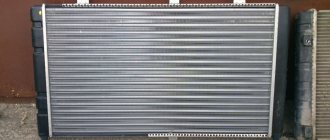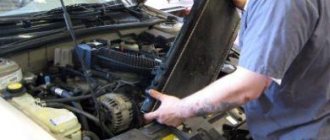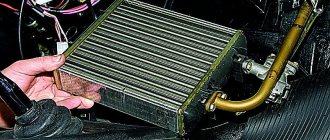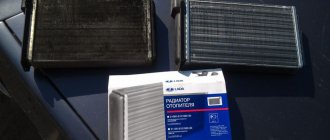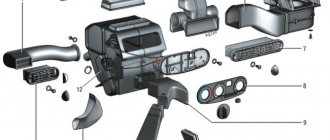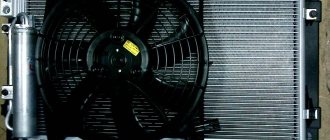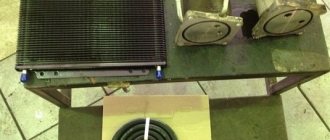Cooling radiator for VAZ cars
VAZ 2114 is considered one of the most striking examples of success of the domestic automobile industry. This model is a modified version of the VAZ 2109 and differs from it in the design of the front part of the body, updated headlights and hood, radiator grille design, as well as plastic moldings and spoilers. However, as it became known, the car is susceptible to radiator failures, which can lead to overheating, and as a result, to engine failure.
Required spare parts
First of all, you need to select a new radiator. It is better to purchase an analogue of what is on your car. You can also make a choice by article number: 2108-1301012, 21082-1301012, RO2108-01, LRc 01082.
The average price of a new unit is 1,750 rubles. Copper models will cost more.
Attention ! It is better not to purchase painted radiators, since there is a risk of an unpleasant odor appearing in the interior, and the heat transfer of these models is lower.
What determines the cost of a radiator?
There are several factors that affect the final cost of a given element.
The first is the manufacturer . Original spare parts are always very expensive, so many car owners try to replace them with imported analogues in the event of a breakdown. Today, the following companies are in great demand in the Russian car market:
- DAAZ.
- BAKER.
The second is the characteristics of the radiator . For this car model, the radiator is made of two types of metal: copper and aluminum. Each of them has its own unique characteristics that allow it to perform better.
This heat exchanger has no varieties, apart from its design. Therefore, the specific cost will be based only on the characteristics.
Tools required for repairs
If you want to do the repairs yourself, you need to prepare the following tools:
- keys for 8 and 10;
- screwdrivers;
- heads for 8 and 10;
- pliers;
- container for draining antifreeze;
- jack;
- sealant;
- rags.
Independent work is completely justified, since as of March 24, 2019, the average price for replacing a cooling radiator for a VAZ 2114 and other models is 2.2 thousand rubles. Which will more than double costs.
On a note! It is not difficult to monitor the efficiency of the radiator and reduce the risk of engine overheating. It is necessary to regularly check the volume of coolant in the tank and the operation of the thermostat.
Order of Operations
If the car has a low seating position or the coolant drain tank is large, work should begin by lifting the car with a jack. The radiator is installed on the TV along with fog and regular headlights. Work should only begin with a cold engine. If the engine is hot, be sure to wait until it cools down.
On a note! Mandatory conditions for performing operations are strict adherence to the sequence and extreme accuracy. Because the engine cooling system is one of the main ones in a vehicle. In parallel with the replacement, it is advisable to revise it and make sure that other components are in good working order and are working properly. Now you can get started:
- After removing the plug from the expansion barrel, the working fluid is drained into a container. It is necessary to drain all the antifreeze that is in the cooling system.
- Now you need to dismantle the filter.
- The radiator must be removed together with the electric fan. To do this, you need to disconnect the power supply to the cooler. Now you need to unscrew the pressure plate and remove it.
- Now you need to remove the inlet and outlet hoses from the pipes. To do this, loosen the fastener clamp.
- The radiator with fan is tilted towards the engine and removed. Attention! Before pulling out the fan, you need to disconnect the wires. They are usually located at the bottom of the device. This is necessary in order to maintain the functionality of the wiring.
- Now you need to disconnect the fan from the radiator. To do this, use a 10mm wrench to unscrew 2 nuts. The fan must be removed along with the casing.
- Installation of the radiator is carried out in the reverse order to that described above. It begins with switching the new node and the fan. Important! Before replacing, make sure that there are 2 rubber cushions. If they are missing, install new ones in the crossmember holes. If they are in place, then the installation of the new unit is carried out on them. The main causes of radiator malfunction
The most common reasons for radiator failure on VAZ 2113, 2114, 2115 are:
- mechanical shocks, for example, stones bouncing off the wheels of passing vehicles;
- pockets of corrosion and contamination inside the tubes;
- damage in an accident.
Step-by-step replacement process
- Open the hood and unscrew the two bolts securing the filter housing to the front panel. Ten head bolts.
- Press the latch and disconnect the mass air flow sensor power connector.
- Lift the filter housing and move it to the side.
Unscrew the two nuts securing the radiator clamp and slide it forward from under the front panel. Eight head nuts.
Press the lock and disconnect the fan power cord.
Loosen the clamp and disconnect the pressure relief pipe from the radiator.
Remove the radiator along with the fan.
Remove the four bolts securing the fan to the radiator.
Move the two rubber silent blocks from the old radiator to the new one or install them in the holes on the body.
Install the fan onto the new radiator and secure with bolts.
Place the radiator in place and be sure to ensure that the radiator silent blocks fit into the holes on the body.
Let's summarize
In general, repairs are quite accessible for doing it yourself, but you need to immediately prepare for a significant time investment. Work can last for 2-6 hours. When replacing the radiator, it is necessary to change the coolant. Work with 8-valve and 16-valve engines is carried out in the same way. If the car has air conditioning, you will have to remove and install it during the repair, but not on all models. It is advisable to replace the bushings at the same time. The work is completed by checking the functionality of the engine and the condition of the coolant. Namely, whether it is boiling.
For greater clarity on replacing the VAZ 2115 injector cooling radiator, you can watch this video:
Replacing the cooling radiator for a VAZ 2114
VAZ 2114 is considered one of the most striking examples of success of the domestic automobile industry. This model is a modified version of the VAZ 2109 and differs from it in the design of the front part of the body, updated headlights and hood, radiator grille design, as well as plastic moldings and spoilers. However, as it became known, the car is susceptible to radiator failures, which can lead to overheating, and as a result, to engine failure.
Replacing the cooling radiator
It is worth noting that the radiator from 2114 is also suitable for other representatives of the VAZ model range. As you know, VAZ’s developments are universal, so it is not surprising that not only cooling system parts, but also other spare parts from earlier and later models of this brand will ideally fit the 2114.
As one of the main parts of the cooling system that is in constant operation, the radiator may require replacement because it becomes clogged with debris or suffers mechanical damage. In addition, the coolant must be replaced in a timely manner, otherwise it will corrode it from the inside, which will undoubtedly lead to breakdown.
How to remove the old one?
Dismantling the cooling radiator and its pipes VAZ 2114
Before a replacement is made, regardless of the vehicle manufacturer, it is worth remembering that the process of dismantling the old and installing a new radiator must be carried out on a cold engine, and the VAZ 2114 is no exception. In addition, before replacing this spare part, you must disconnect the battery and drain the coolant by unscrewing the plug located at the bottom left.
To avoid burns, be sure to cool the engine before draining coolant.
- After draining the cooling liquid, you need to remove the air filter secured with two bolts, freeing the air duct filter by loosening the clamp.
- After the radiator is freed from the air filter, it is necessary to dismantle the protective screen provided by the VAZ developers. To do this, you need to loosen the upper fastenings, remove the iron clamp and loosen the return clamp of the expansion tank.
- You should also remove the pipes: the upper one can be dismantled by loosening the iron clamps using a 8-mm wrench or a screwdriver, while the lower one, in most cases, is not only screwed to the thermostat, but also sealed with a special sealant that prevents fluid from leaking from the radiator. To remove the lower pipe, you need to remove the sealant and loosen the clamp.
- In addition, it is necessary to disconnect the fan power cord, after which the part itself can be removed by removing the landing pads.
Removing the radiator and its fastenings - Then you need to remove the fan, screwed on with several nuts. The main work of dismantling the main part of the engine cooling system has been completed, the only thing left to do is replace it.
How to secure a new one
- Connect the fans to the new cooling system and tighten them with nuts.
- After this, carefully insert it into place, putting the landing pads on it, and connect the power plug to the fan.
- Then you need to secure the lower pipe to the thermostat, generously lubricating it with sealant to prevent leakage, and also secure the upper one and tighten the clamps.
- Next, you need to fix the expansion tank return clamp, attach the screen and secure the iron clamp.
- After this, you should install the air duct and air filter, also securing it with a clamp.
COOLING SYSTEM PROBLEMS
As a rule, due to malfunctions in the cooling system, the engine overheats, and this leads to engine failure. Any of the elements may be faulty.
Radiator:
- It may leak. Possible leakage through aluminum tubes and plastic tanks. Often the plastic outlet for the return hose of the expansion tank breaks off.
- It may clog, and for this reason the engine will heat up.
Pipes. Because of them, antifreeze leaks due to the fact that the pipe:
- Ragged.
- Old and lost elasticity.
Thermostat. Depending on how incorrectly the valve in the thermostat operates, the internal combustion engine can:
- Overheat (in this case, the antifreeze “throws out” through the expansion tank).
- Do not reach operating temperature. As a result, the car drives poorly, and in cold weather it is cold inside the car.
Water pump (three main problems):
- Noise and play in bearings. It is not worth driving with such a defect for a long time; the pump may jam or fall apart.
- Liquid is leaking through the inspection hole. It also signals the imminent “death” of the part.
- Broken impeller. With such a defect, the engine overheats very quickly.
Cooling Fan:
- A faulty fan also leads to overheating of the internal combustion engine.
The clamps may be faulty or poorly tightened. It happens that thin hoses become clogged with debris (“return”, throttle valve heating).
Refilling a new radiator
Coolant refill
Finally, “Tosol” or antifreeze should be poured into the expansion tank of the new radiator. Basically, approximately 5-8 liters of liquid are poured into the new cooling system to cool the engine. After filling with antifreeze, the car must be started and left running for a few minutes so that the thermostat opens and the antifreeze goes into the engine cooling system. Replacing the 2114 radiator, like any other VAZ model, should be carried out in a warm room or in the summer season.
What is a radiator and what is its function?
The radiator looks like a rectangular box made of numerous and very thin slats. Inside, it is a system through which the coolant passes and is cooled by the oncoming air flow. At the end sides of this element there are two pipes to which water cooling hoses are connected.
The principle of its operation is very simple. When the driver starts the car, the engine begins to work, but the harder and longer it does useful work, the higher its temperature. It's no secret that the fuel-air mixture ignites in the upper part of the cylinder blocks of the power unit. Around this zone there are channels through which coolant flows. The water pump accelerates it under pressure and it enters the “hot” zone. Having made a circle and absorbed the heat, it returns to the radiator. And since it is open to air flow, it cools the liquid, which then repeats its cycle many times.
